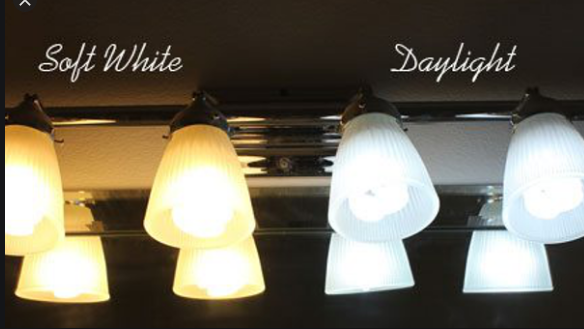LED light bulb is an electric light for use in light fixtures that produces light using one or more light-emitting diodes (LEDs). LED lamps/ bulbs have a lifespan many times longer than equivalent incandescent lamps and are significantly more efficient than most fluorescent lamps. LED bulbs offer light in a range of color temperatures; it’s what makes light feel warm or cool. A lower color temperature produces a warmer, more relaxing light. A higher color temperature emits a cooler, more refreshing light. Color temperature of light bulbs falls in a spectrum along the Kelvin absolute temperature scale. The greater the Kelvin number, the cooler the light appears.
In addition to lumens (brightness), Kelvin numbers and CRI (color rendering index), many LED bulbs come with descriptors such as Soft white light, daylight, bright light or cool white, all aimed at giving you an idea of what the bulb will look like once it’s in your home. Therefore a better understanding of the differences between soft white and daylight bulbs can help you choose the bulb that will be best for you and your home.

Soft White LED
Soft white bulbs also referred to as warm white bulbs have a color temperature that falls in the range of 2700K to 3000K. Soft whites have a yellow tone, which is considered a ‘’warm color’’. Soft white or warm white is popular to most people because it’s the color of light produced by most incandescent bulbs. Warm white lighting exudes the feeling of warmth, calmness and relaxation, making it ideal for bedrooms, dining rooms and living rooms.
What You Need To Know About Soft White LED
- Soft white LED bulbs produce a lower color temperature in the range of 2700K to 3000K.
- Unlike daylight bulbs, soft white is richer in yellow and red thus providing a warm light.
- Bulbs that are marked as soft white or warm white or Kelvin below 3000Kproduce a warm white produce a white light providing a warm, cozy feel to your living room.
- Soft white bulbs are ideal for overall illumination in areas such as living room, bedrooms, dining halls etc.
- Soft white bulbs replicate a yellowish white light that the regular incandescent bulbs give off.
- Due to its lower color intensity, soft white makes light feel warm, producing a more relaxing light.
- Given that the soft white emits a yellowish light, they are create some strain on the eyes and thus may not be suitable for reading or working on projects.
Daylight LED
Daylight bulbs have a color temperature that falls in the range of 5000K to 6000K. These bulbs give off light that appears distinctly shaded with blue and simulates the natural color of daylight. Lighting with daylight bulbs produces a vibrant and intense illumination that is often perceived as overly harsh for home use. However, it is ideal for a home workshop, sewing or craft room, because it provides clear illumination for detail-oriented work. Daylight bulbs are also suitable for lighting a display area such as shelves holding books or collectibles and for security lighting.
What You Need To Know About Daylight LED
- Daylight produces a higher color temperature in the range of 5000k to 6000K. Color temperature in the range of 5000-6000K is considered very white.
- Daylight LEDs emit light across the full spectrum of natural light, and thus it creates more of a bluish-white color.
- Daylight bulbs produce bright white or mimic natural light of sun and its ambient color makes it ideal for kitchen bathrooms, basements, recording videos etc.
- The exceptionally bright yet natural light, daylight LEDs causes less strain on eyes and thus is suitable for reading or working on projects or for accent lighting.
- Daylight LED provides an instantaneous warm glow to your interiors just like the sun’s natural light.
- Because of its lower color intensity, it makes light feel warm, producing a more relaxing light.
Difference Between Soft White And Daylight LED In Tabular Form
| BASIS OF COMPARISON | SOFT WHITE LED | DAYLIGHT LED |
| Color Temperature | Soft white LED bulbs produce a lower color temperature in the range of 2700K to 3000K. | Daylight produces a higher color temperature in the range of 5000k to 6000K. |
| Replicates | Soft white bulbs replicate a yellowish white light that the regular incandescent bulbs give off. | Daylight bulbs produce bright white or mimic natural light of sun. |
| Eye Strain | Given that the soft white emits a yellowish light, they are create some strain on the eyes and thus may not be suitable for reading or working on projects. | The exceptionally bright yet natural light, daylight LEDs causes less strain on eyes and thus is suitable for reading or working on projects or for accent lighting. |
| Ambience | Due to its lower color intensity, soft white makes light feel warm, producing a more relaxing light. | Daylight LED provides an instantaneous warm glow to your interiors just like the sun’s natural light. |
| Color | Unlike daylight bulbs, soft white is richer in yellow and red thus providing a warm light. | Daylight LEDs emit light across the full spectrum of natural light, and thus it creates more of a bluish-white color. |
| Suitability | Soft white bulbs are ideal for overall illumination in areas such as living room, bedrooms, dining halls etc. | Daylight bulbs produce bright white or mimic natural light of sun and its ambient color makes it ideal for kitchen bathrooms, basements, recording videos etc. |